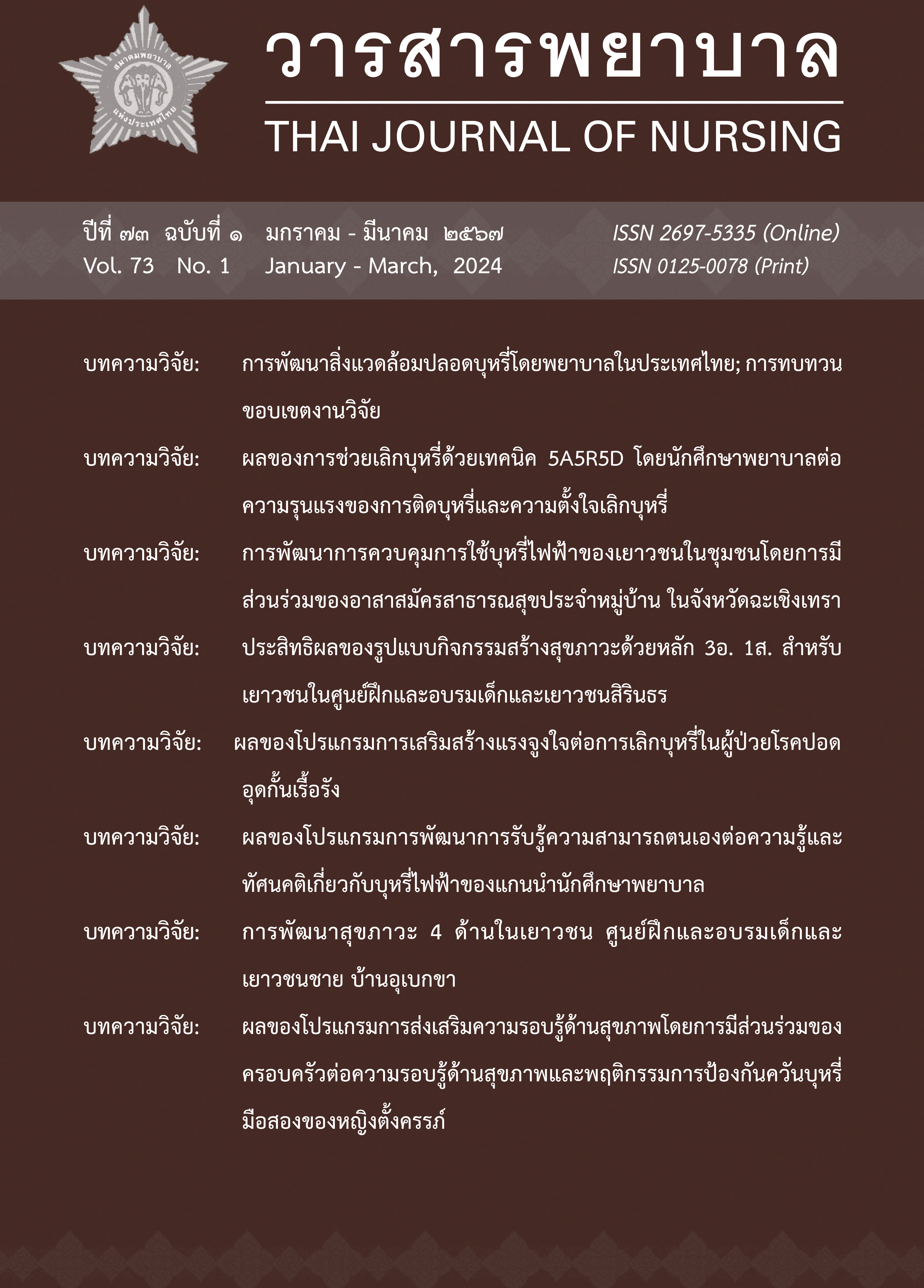Development of 4 areas of health among youth in Ban Ubekkha’s Juvenile Vocational Training Center
Main Article Content
Abstract
This quasi-experimental research aims to evaluate the health of youth in Ban Ubekkha’s Juvenile Vocational Training Center in 4 aspects including nutritional consumption behavior, exercise and physical activities, stress management, tobacco cessation and smoke - free environment management and the overall well-being. Based on review literature and the context of the training center, 65 youths participated in this study. Results showed that, after receiving the health development program, the youths got better nutritional consumption behaviors in basic nutritional knowledge of not being consumed too often, better knowledge and attitudes toward good nutritional behavior, and healthy food selection. . They could cope better with stress in the part of emotional tolerance. They also perceived better physical health significantly at p < .05. The smoking cessation behavior and smoking free environment management after the activities, revealed that 75.4 and 66.2 percent of youths could quit smoking at the 3 month, and the 6 month follow up respectively.
Article Details

This work is licensed under a Creative Commons Attribution-NonCommercial-NoDerivatives 4.0 International License.
References
กระทรวงสาธารณสุข กรมสุขภาพจิต สำนักส่งเสริมและพัฒนาสุขภาพจิต. (2558). คู่มือการส่งเสริมสุขภาพวัยรุ่นและเยาวชนในชุมชน. โรงพิมพ์ชุมนุมสหกรณ์การเกษตรแห่งประเทศไทย.
ขวัญชนก เคนสี. (2563). พฤติกรรมการเลียนแบบ สัมพันธภาพในครอบครัว ทักษะชีวิตกับพฤติกรรมเสี่ยงทางเพศของนักเรียนชั้นประถมศึกษาปีที่ 6 ในเขตหนองจอก กรุงเทพมหานคร. วารสารสังคมศาสตร์และมนุษยศาสตร์, 46(1), 113-145.
จุฑารัตน์ อยู่สุขเจริญ. (2560). ปัจจัยทำนายความตั้งใจเลิกบุหรี่ของผู้ป่วยโรคไม่ติดต่อเรื้อรังโรงพยาบาลธรรมศาสตร์เฉลิมพระเกียรติ (วิทยานิพนธ์ปริญญามหาบัณฑิต ไม่ได้ตีพิมพ์). มหาวิทยาลัยธรรม ศาสตร์.
ณภัสวรรณ ธนาพงษ์อนันต์ และ ญาณภัทร สีหะมงคล. (2564). การสร้างเกณฑ์ปกติสมรรถภาพทางกายที่สัมพันธ์กับทักษะของนิสิตสาขาวิทยาศาสตร์การกีฬา คณะศึกษาศาสตร์ มหาวิทยาลัยมหาสารคาม. วารสารการวัดผลการศึกษา มหาวิทยาลัยมหาสารคาม, 27(2), 99 - 115.
ตฤณห์ โพธิ์รักษา. (2565). อิทธิพลของสื่อที่มีผลต่อพฤติกรรมความรุนแรงของเด็กและเยาวชน. วารสารรัฐศาสตร์รอบรู้และสหวิทยาการ, 5(2), 98-116.
ลักษมล ลักษณะวิมล, เรวดี เพชรศิราสัณห์, สายฝน เอกวรางกูร, และนัยนา หนูนิล. (2563). ปัจจัยที่สัมพันธ์กับพฤติกรรมการสูบบุหรี่ของเยาวชนอำเภอท่าศาลา จังหวัดนครศรีธรรมราช. วารสารพยาบาล, 69(1), 1–9.
วนิดา เสนะสุทธิพันธ์ และ อาภาวรรณ หนูคง. (2558). ปัจจัยทำนายพฤติกรรมการออกกกำลังกายและการทำกิจกรรมทางกายของวัยรุ่น. วารสารสภาการพยาบาล, 30(2), 46-59.
ศิริวรรณ จินตา. (2564). การประเมินปริมาณโลหะหนักที่ปนเปื้อนในผักเศรษฐกิจ:กรณีศึกษาในตำบลบึงพระ อำเภอเมือง จังหวัดพิษณุโลก. PSRU Journal of Science and Technology, 6(1), 28-38.
สำนักงานกองทุนสนับสนุนการสร้างเสริมสุขภาพ. (2563). จับตาทิศทางสุขภาพคนไทย ปี 2563. https://resourcecenter.thaihealth.or. th/files/90/จับตา%2010%20พฤติกรรมสุขภาพคนไทย%20ปี %2063.pdf
สำนักงานสถิติแห่งชาติ. (2561). การสำรวจพฤติกรรมการบริโภคอาหารของประชากร พ.ศ.2560. https://shorturl.asia/GbNOm
Cherry, K. (2020). Erikson's stages of psychosocial development. https://www.verywellmind.com/erik-eriksons-stages-of-psychosocial-development-2795740
World Health Organization. (2019). WHO report on the global tobacco epidemic 2019: offer help to quit tobacco use. https://www.who.int/publications/i/item/9789241516204


